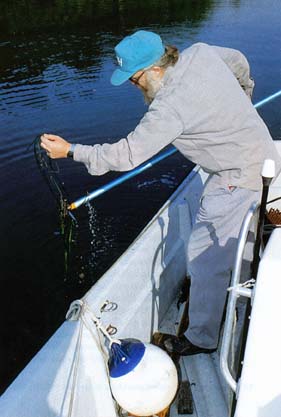 |
 |
| current issue |  | past issues |  | send a letter/news |  | address update |  | advertise |  | about us |  | alumni home |
Features
|
Life on the Edge
New Hampshire's Great Bay is a stunning outdoor laboratory for UNH researchers, who are leading an unusual cooperative effort to defend our nation's fragile estuaries. By Suki Casanave '86G |
Easy to print version Make a comment |
Sidebar: How to visit Great Bay
"In the recurrent rhythms of tides and surf and in the varied life of the tide lines, there is the obvious attraction of movement and change and beauty. There is also, I am convinced, a deeper fascination born of inner meaning and significance." --Rachel Carson, The Edge of the Sea
Fred Short wields a wicked hook. Bending across the port side of his skiff, one early morning in May, he peers into the murky depths and digs around to see what he can dredge up. A few skillful twists of his long-handled tool and up comes a dripping green mass. Short eyes the limp eelgrass, spreading the stalks with practiced fingers. He pauses when he finds what he's looking for--the "flower." Bright in the morning light, the neat diagonal pattern of seeds stretches only an inch or two along one stalk, a tiny emerald zipper in the palm of his hand.

|
Short has been monitoring this four-acre eelgrass bed for more than 10 years. He has spent hours here, and at about a dozen other sites in New Hampshire's Great Bay, hunched over the side of a boat fishing for grass most people have never heard of. Why does he do it? "Eelgrass is a pollution sentinel," says the University of New Hampshire's research associate professor of natural resources and marine sciences. Susceptible to certain aspects of water quality, eelgrass--for all its lack of glamour--is a significant indicator of a healthy estuary.
UNH researchers like Short have been at work in Great Bay for years, studying pollution impact, keeping careful watch over one of New Hampshire's most treasured natural resources. Last year, the university's well-established research became the foundation for a new institute to help protect our nation's estuaries. Launched with $5.9 million in federal funding, the Cooperative Institute for Coastal and Estuarine Environmental Technology (CICEET) is forged from an unusual partnership between the university and the National Oceanic and Atmospheric Administration (NOAA).
The institute will be housed in UNH's new Environmental Technology Building, scheduled for construction in 1999. But its influence will extend far beyond university walls. Twenty-two National Esturarine Research Reserves, including New Hampshire's Great Bay, will serve as outdoor laboratories for institute research. And scientists across the country, supported by institute funding, will now collaborate more closely, working toward solutions, defending our precious estuary ecosystems.
"The Land Between"
Aptly described by Native Americans as "the land between," estuaries form the fragile fringe between earth and sea. Here where solid land gives way to the steady rhythms of the tides, fresh river waters mix with ocean salt water, creating one of the richest and most significant ecosystems on earth.
New Hampshire's Great Bay provides a banquet for countless birds and wildlife. More than 23 species of threatened or endangered plants and animals depend on these estuary waters, including the bald eagle and peregrin falcon. Striped bass migrate north from the Chesapeake Bay each summer to feed on minnows, silversides, and smelt that live in the estuary. Herons prey on fish and eels. Sandpipers and plovers search the mud for shrimp, small crabs, and amphipods that live in the sediment. Local fishers pull flounder, bluefish, lobsters, and shellfish from these waters. The great whales themselves could not survive without the microscopic nutrients flushed from the salt marshes out to the open sea.
 Eelgrass, dredged up here by Associate Professor Fred Short, reveals an estuary's state of health.
Eelgrass, dredged up here by Associate Professor Fred Short, reveals an estuary's state of health.
|
"Estuaries are often called 'nurseries of the sea,'" says Peter Wellenberger, director of the Great Bay Estuarine National Research Reserve. "Their productivity per square foot is just immense. Many of the commercially valuable fish and shellfish in the world have some connection to an estuary."
Humans, too, are drawn to the ocean. More than 50 percent of the US population now lives within 50 miles of the coast. One in every six jobs in the US is marine-related. We love to boat, swim, and fish the coastal waters. We relish fish, lobster, and other shellfish. But our attraction to the coast is also its greatest threat. Chemicals from our lawns and pollutants from our roads run off into the water. We tear up shoreline vegetation with our boats, damage the ocean bottom with fishing equipment, and deplete the fish supply with overfishing. Wastewater treatment plants overflow and oil spills leave behind deadly scum.
While there have been significant improvements in wastewater and sewage treatment methods in the recent decades, estuaries continue to face a looming threat: population pressure. For three decades, the New Hampshire Secoast has grown faster than any other region in the state. Looking ahead, planners predict more of the same. "Think of it this way," says Tom Duffy senior planner for the Office of State Planning. "Portsmouth had about 22,800 residents in 1996. By the year 2020, the Seacoast will have another seven Portsmouths."
"More Portsmouths" mean more septic systems, more cars and trucks, more subdivisions and industry--all of which adds up to more polluted run-off into Great Bay. Other estuaries around the country face the same predicament: whatever happens on land, directly affects what happens in the water. "Our estuaries are in trouble," says Laurie McGilvray, acting NOAA co-director of the institute. "About 45 percent of our coastal waters are threatened or impaired from polluted runoff, which could limit the public's ability to fish, swim, and enjoy the coast now or in the future."
blog comments powered by Disqus

